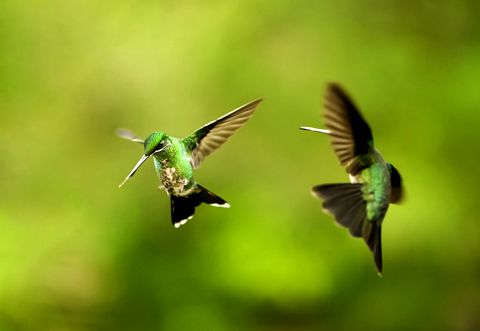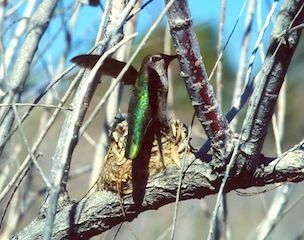Hummingbird Mating and Behavior
Hummingbird mating is as unique and special as the hummingbird itself.
The conjugal act is referred to as a cloaca kiss. The cloaca is located near the posterior of a hummingbird’s body.
The cloaca in hummingbirds is the only opening so, in addition to reproduction, it’s also utilized for intestinal and urinary purposes.
The Mating Dance

The actual mating act takes no more than five seconds.
It’s a quick and simple obligatory act.
These amazing birds aren’t social.
In fact, hummingbirds don’t migrate or flock together.
Their lives are quite solitary.
After a male has staked out his territory he lets the female hummingbirds know he’s ready for mating.
He begins with a process of puffing out his throat and chest. He then begins to throw his head from side-to-side. This ensures that his bright feathers shine in the light.
He’ll also stretch out his body and tail as he hovers in front of a perched female so she can see his entire body. He’ll even fly in front of her back and forth in a show of stamina of strength.
I encourage you to watch this hummingbird mating act if you’ve never seen it before. It’s interesting indeed.
The mating process continues as the male performs amazing acrobatic flight patterns that include flying upwards of 15 meters or more. He then speed dives until the last possible moment only to swing up in a U-turn.
This continues until the male runs out of energy or when the female makes her choice. The male hummingbird also “sounds off” loudly with his wings and makes vocal chitters to keep the attention of the female.
The female hummingbird often chooses the most energetic male. Females may also select the male bird with a territory most abundant in nectar, food or water.
As soon as the moment is over so is their friendship. The “father” hummingbird isn’t welcomed anymore. At this point, he continues to court other females.
Nesting

While the male hummingbird’s task is to secure territory by choosing one that has lots of colorful nectar producing flowers, the task of nest building belongs to the female hummingbird.
This is the normal behavior in most cases.However, there is evidence to suggest that the species Colibri, or Green Violet-ear, does participate in the nesting and raising of the babies. Coming to a definite conclusion is difficult because it's hard determine sex by just the plumage.
Assuming our little ladybird is doing the chores, she uses plant materials such as grass, animal hair and lichen to build her nest. She borrows the sticky substance from the spider’s web to hold and shape her nest, and adhere it to its location. In order to protect her home the nest is often up high and camouflaged within a tree.
Hummingbird nests are usually about the size of half a golf ball. They’re easy to miss. If you happen to find a hummingbird nest you should consider yourself extremely lucky!
Hummingbird Incubation and Birth
Typically, the female lays her eggs two days apart. Incubation then begins and lasts between 12 and 15 days. If the day temperature is cooler than ideal additional days are needed.
She then broods, feeds and cleans her baby hummingbirds and nest while primping and grooming herself. The baby hummingbird’s diet consists of nectar and small insects.
On average, about four weeks after hatching most baby hummingbirds will outgrow their nest and have all their feathers.
When the warm weather makes way for the cooler season hummingbird mating will conclude in time for migration. The birds will fly south again but will return at the same time next year to mate again.
If you grow a bright garden of nectar producing flowers and add a few hummingbird feeders, you just may see a mother hummingbird tending to her babies. Good luck!
Subscribe to my updates!
Hummingbirds > Hummingbird Migration > Hummingbird Mating





